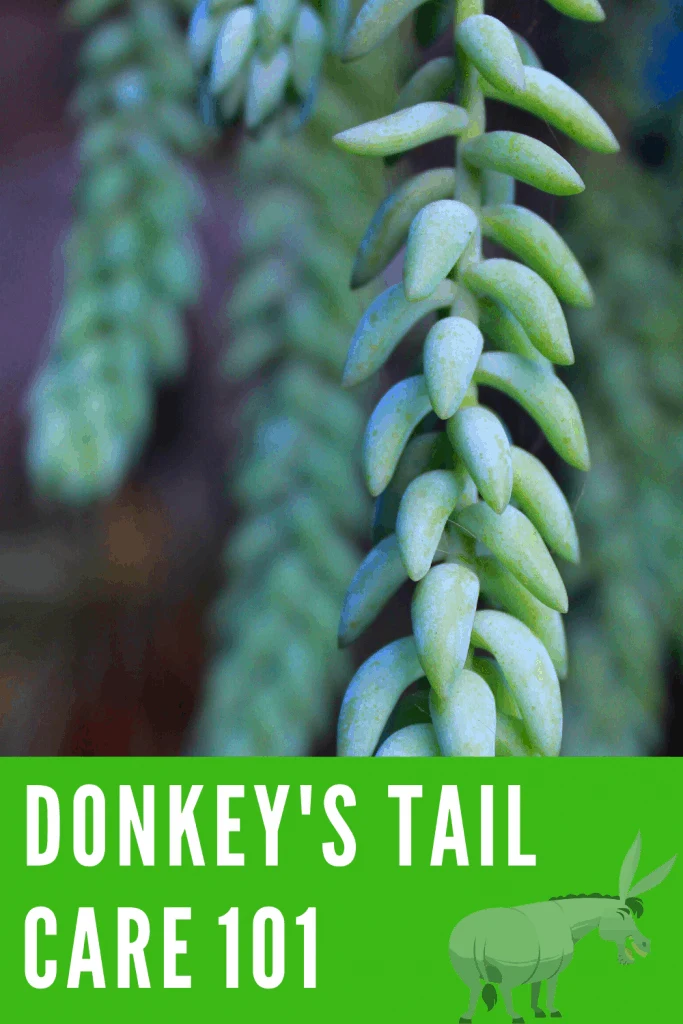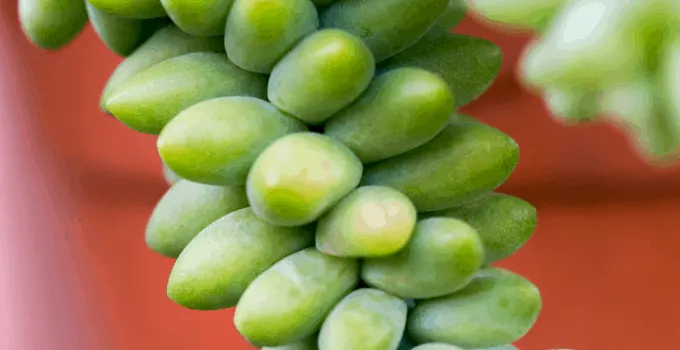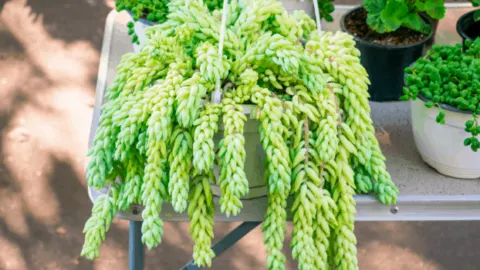The Donkey’s Tail, also called Burro’s Tail or Sedum morganianum (botanical name), is a succulent loved for its iconic leaves.
Belonging to the family Crassulaceae, this individual sports fleshy, modified leaves. And as you would assume, this foliage grows in a bottlebrush style, similar to a donkey’s tail.
These perennials are naturally found in areas extending from the southern tip of Mexico to Honduras. This species is considered “micro endemic, ” which implies their heavily restricted range.
Donkey's Tail Takeaways
| Species | Sedum morganianum |
| Synonyms | Sedum burrito, Burro's tail, Donkey's tail |
| Family | Crassulaceae |
| Genus | Sedum |
| Growth | Trailing, succulent |
| Height | 2 feet |
| Width | 3 feet |
| Soil | Well-draining soil mix that doesn't retain water for too long |
| Watering | Every 14-21 days |
| Light | Bright indirect |
| Temperature | 65-80 °F (18-26 °C) |
| Humidity | 40-50% |
| Fertilizer | Fertilize monthly in spring and summer |
| Propagation | Stem cuttings or leaves in well-draining soil mix |
| Toxicity | Non-toxic to cats and dogs. Keep it away from children. |
Donkey’s Tail Succulent Care
Provide well-draining cacti or succulent soil. Bright indirect light is best. The temperature should be 65-80 degrees Fahrenheit (18-26 degrees Celsius). Water every 14-21 days. Fertilize once a month in spring and summer.

This habitat includes cliffs lined with rocks. These succulents can handle a myriad of conditions, including your home. Many consider them relatively easy to succulent to care for, even with slightly sensitive burro-like leaves.
Table of Contents
Donkey’s Tail Plant Care
You may have heard this plant called the lamb, donkey, or horse’s tail. Either way, it is relatively simple in terms of overall care.
Soil
Well-draining soil. Succulent soil works fine. The typical potting soil does not achieve this level of porous qualities.
You’ll want to invest in a potting mix that has desert plants in mind. This can include ones designed for cacti and succulents.
These generally have higher sand, perlite, and pumice levels than a regular potting mix. Gritty soil will prevent the water from sitting for too long.
We have an article about the Yucca that also requires properly draining soil!
Light
Bright indirect light.
Perhaps the most important requirement for Sedum morganianum is the amount of light it receives daily. On the lower end, your Donkey’s Tail plant should get at least four hours of high light.
But what do we mean by “high” light? Most would assume this to be direct sunlight. That’s where houseplant owners get into trouble. Direct light can burn the foliage, even for sun-hungry succulents like Sedum.
Instead, try to put your plant in a spot that gets four hours of bright, indirect light exposure. Opting for a location such as on a windowsill, patio, or balcony.
Regardless of where you’ll put your Donkey’s Tail, ensure it meets the minimum requirement of four hours.
Watering
Water every 14-21 days. Use your index finger and water once the soil is dry to the touch 2-3 inches down (5.0-7.5cm)
Enough water should be used to saturate the plant down to the roots thoroughly, and still concerned about the watering details? Don’t fret! We’ll discuss this briefly later on.
Temperature
The ideal range is 65-80 degrees Fahrenheit (18-26 degrees Celsius). Being native to the southern regions of Mexico, these succulents prefer warmer temperatures.
These indoor plants do not tolerate temperatures below 50 degrees Fahrenheit for an extended time (10 degrees Celsius).
Don’t place it next to an open window during the colder months.
Humidity
40-60% humidity is ideal.
The humidity in most homes is enough to keep a Donkey’s Tail succulent happy.
Fertilizer
Fertilize once a month in spring and summer.
One of the biggest questions people have regarding the care of a plant is if it needs fertilizer. Some do, especially those who produce large, decorative flowers!
The Donkey’s Tail plant has flowers that are anything but flashy. For this reason, these succulents aren’t entirely dependent on fertilizer to bloom. Limiting food to the growing season is best if you want to implement food.
This should not be done more than once a month. Sedum morganianum does best when given weak solutions specifically designed for desert plants. When in doubt, we suggest opting out of using fertilizer.
Propagation
Succulents are known for being propagated without any problems! This is mainly because they root rather easily.
The Donkey’s Tail plant can even be copied through dropped leaves that you tend to for a few days. You can either proceed with this method or opt for the more typical stem cutting.
The method depends on how much of a new plant you want. Using the leaves that drop simply adorns your already existing plant and makes it fuller. Stem cuttings will bring about a whole new individual.
Growth
Compared to most other houseplants, you’ll be surprised that your Sedum will take a while to mature fully. They grow in a pendant pattern, where the leaves trail down.
This makes them an ideal candidate for hanging baskets. The leaves can be up to 60 centimeters in length. The flowers, as we’ve mentioned before, are quite small. They are only a few inches in total.
The whole plant, though rare, can be around four feet long. This takes quite a while, as they are incredibly slow at growing. Sedum morganianum will generally reach its full potential at around six years.
Potting
The process of repotting can be a bit risky for this succulent. Those fleshy leaves are quite fragile, easily falling off the plant when handled too much.
You might have a healthier succulent if you can get by not touching your Donkey’s Tail. Fortunately, these plants don’t require frequent repotting.
Unlike other flora, they prefer to let their roots become bound within a small container. Most houseplants will face the consequences of cramped roots.
The only time that you will likely need to repot your Donkey’s Tail is if it is experiencing some disease and needs a fresh batch of soil.

Watering
Water Sedum morganianum every 2-3 weeks. This depends on several factors, such as the humidity, temperature, and sun exposure your plant receives.
The typical Donkey’s Tail plant should be given moisture between ten and fourteen days. This watering routine includes a thorough watering enough to saturate the roots.
To avoid root rot, ensure plenty of drainage holes on the bottom of the pot.
Donkey’s Tail Propagation
As with most succulents, making new individuals is rather easy, especially considering the process of copying most houseplants. One of the easier methods involves simply taking the leaves that have fallen from your Sedum.
Placing them on top of the appropriate potting mix and lightly watering them can create new plants. You can also opt for the classic stem cutting, which we’ve described below.
Propagation Steps
- Locate a plant you’d like to propagate, preferably one with healthy growth throughout the season.
- Make clean incisions along the stems about three to four inches long.
- Remove the last half of the leaves still attached to the stem.
- Instead of immediately placing them into a pot, hold off until the stems have healed from where the incisions have been made. This can be anywhere between two weeks to three months.
- Place your stem cuttings into the soil, pinning them down if necessary.
- Water your Donkey’s Tail every other week until it has rooted, and then transplant it to a new pot.
Pests
Although low-maintenance, these plants can fall privy to several issues involving insects.
Raising a plant indoors limits the number of infestations they are likely to get. But bugs can be in the soil you buy at the store, or even come in through the window. Knowing what to look for is key to the overall health and well-being of your Donkey’s Tail plant.
We’ve already touched on the potential for root rot. They can also fall victim to black or sooty mold. This is rather easy to treat. Making a spray with diluted dish soap can tackle any mold and rid the plant of a few insects.
Most of the time, mold will be present alongside insects.
Among the more common pests are aphids, scale insects, and mealybugs. Preventative measures should be done with care, as the leaves are incredibly fragile.
Aphids can usually be removed with a simple hose down. Just make sure that the pressure isn’t too high. Organic neem oil can also combat such pests with soft misting. This method may take a few weeks to become successful.
Donkey’s Tail Problems
Problems can present themselves in a myriad of ways. Being observant is the first step in understanding what your Sedum needs. Here are a few hints that you may see if an issue arises.
TELLTALE SIGN #1: Loss of leaves
The foliage of Sedum morganianum is extremely sensitive. If the leaves start to drop, this may be due to low humidity or light levels.
It may be easier to increase the overall humidity first, then continue to change the spot where your Donkey’s Tail plant resides.
TELLTALE SIGN #2: Soft leaves
It may sound a bit strange, but the foliage may become soft. This is usually a result of overwatering.
Although these plants prefer moisture, allowing your plant to dry out between watering will help restore the leaves’ state.
TELLTALE SIGN #3: Brittle Stems
The stems and leaves are known for breaking off rather easily, even with only moderate handling. This can be one reason. Brittle stems can mean that the plant is too dry.
First, adjust how you handle your Donkey’s Tail plant. You will also want to add more water so that the roots are evenly saturated.
Frequently Asked Questions
Is the Donkey’s Tail plant poisonous?
These plants are non-poisonous. They can cause irritation if consumed.
Where can you buy Donkey’s Tail plants?
You can find Sedum plants in your local garden centers or even online.
Are Donkey’s Tail plants safe to touch?
Touching a Donkey’s Tail will not harm you but can damage the plant. You may not get pricked, but leaving them alone will prevent the leaves from dropping.
The Last Donkey Tail
Donkey Tail plant is easy if you provide bright indirect light and regular temperatures at home. Water every 2-3 weeks and fertilize monthly in the growing seasons.

Daniel has been a plant enthusiast for over 20 years. He owns hundreds of houseplants and prepares for the chili growing seasons yearly with great anticipation. His favorite plants are plant species in the Araceae family, such as Monstera, Philodendron, and Anthurium. He also loves gardening and is growing hot peppers, tomatoes, and many more vegetables.


